Q&A WITH MARTIN Student Life sat down with the Chancellor to discuss his vision.
(News, pg 3)
THE RAT

The extinct bar on campus you never knew existed!
(Scene, pg 5)

Q&A WITH MARTIN Student Life sat down with the Chancellor to discuss his vision.
(News, pg 3)
THE RAT

The extinct bar on campus you never knew existed!
(Scene, pg 5)
SOCCER IN THE CITY Students react to the new MLS team. (Sports, pg 8)
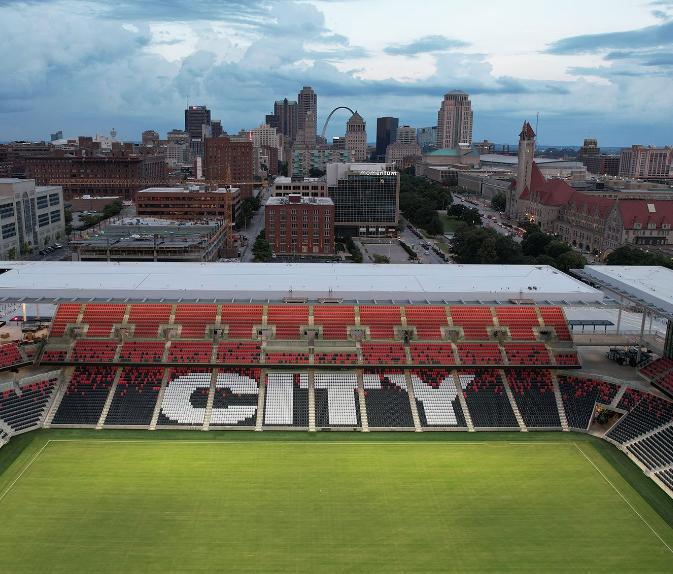
LILY TAYLOR ZACH TRABITZ JUNIOR NEWS EDITORS
Campus Creamery, a new Student Entrepreneurial Program (StEP) campus store selling ice cream, celebrated its grand opening outside the Gregg storefronts on March 30.
Sophomore Harrison Lieber, founder and owner of Campus Creamery, performed a ribboncutting ceremony alongside Chancellor Andrew Martin in front of over 200 attendees who were eager to try Washington University’s only ice cream store. Students waited in line to try the ice cream and its many mix-in variations.
Liber delivered a brief speech to the crowd, expressing his gratitude to his friends, and university members who supported him, including StEP. He also thanked his family, who traveled to be present for the opening.
“I love [WashU],” Lieber said. “I love all my friends here, and I wanted to find a way to enhance student life here. And this was my outlet to do that. And seeing all of you here tonight is really, really exciting, so I hope you all enjoy it.”
The Washington University Undergraduate and Graduate Workers Union (WUGWU) held a march against the University’s handling of sexual harassment and assault cases on Friday, March 31.
The march was attended by 50-60 people and began in the medical school’s Mid Campus Center with short speeches. It lasted about an hour.
Outcries against sexual assault in the medical school became louder after the details of a sexual harassment case, in which a WashU graduate student dropped her PhD degree after her lab’s principal investigator (PI) Dr. Jonathan Kipnis and the University failed to take effective action on her case, were made public.
“It’s critically important that undergraduates are aware of this happening. Sexual assault does not discriminate, and the earlier you can familiarize yourself with it, the earlier you can stop the bullsh*t,” said Talia Lintz, a PhD student and member of WUGWU.
WUGWU, though currently an unrecognized union, focuses on issues that can be solved through collective bargaining. Members saw the case as an issue of student safety and felt they had a role in holding the University accountable for its lack of action.
“The University hopes that our fragile memory does the job of erasing this colossal failure,” said Alejandro Gonzalez, a PhD candidate and member of WUGWU, in an opening speech for the march. “But we will not forget.”
Organizers explained that they circulated a petition which garnered 767 signatures and contained multiple demands for the administration to meet.
Despite the petition, little change occurred, according to WUGWU organizers. Several WUGWU members said difficulties in working with the administration and the HR department had stalled changes from taking place.
“We have heard time and again of serious issues being reported to the administration, only to languish in the black box of human resources with no resolution in sight,” said Gonzalez.
Jamie Moffa, an MD/PhD student and leader of the march, provided further context for the march. “Everyone is clamoring for clarity,” they said. “We met with the administration, specifically with Dr. Eva Aagaard and Dr. Mark Lowe, and even though they said they were open to changing WashU’s policy of mandatory reporting, nothing has happened yet.”
Moffa added that they met with the graduate school’s HR department to bring forward their demands. “We want to strengthen the rules on failures in mandatory reporting. We think that PIs who fail to undertake this role should be put on probation by the University,” they said.
Other demands included the usage of a 3rd-party arbiter in conversations with the University when WUGWU members feel that responses to their demands have been inadequate and for more transparency from the HR department.
Titi Akinwe, a PhD student and WUGWU organizer, referenced toxic lab cultures as another reason for marching.
“This is also a conversation around the culture around sexual harassment here,” they said. “And this is not a new issue here.”
Led largely by Moffa, attendees held signs and chanted as they walked through hallways linking medical and graduate school buildings, so as to avoid patient
areas.
“I JUST WANT A SAFE PLACE TO WORK,” “SILENT IS VIOLENT,” “WASHU HATES MeToo,” “SUPPORT SURVIVORS, NOT ABUSERS,” signs read.
As they marched, attendees chanted “Hold Kipnis accountable!” and “Do more!” — directing these chants at Aagaard, Lowe, medical school Dean David Perlmutter, and Chancellor Andrew Martin.
The march was accompanied by WashU Protective Services Officer Steve Manley. Moffa said that they and Manley had agreed before the march on attendees being able to chant, but that if Manley felt the need to call in other officers, march attendees would disperse.
As the march continued, Moffa and other organizers led attendees to the Farrell Learning and Teaching Center atrium, so they could unfurl a banner that read “WashU, believe #MeToo” over the balcony for everyone to see. Their chants drew confused looks from some onlookers below while others cheered them on. As they approached the balcony, Manley stopped the group.
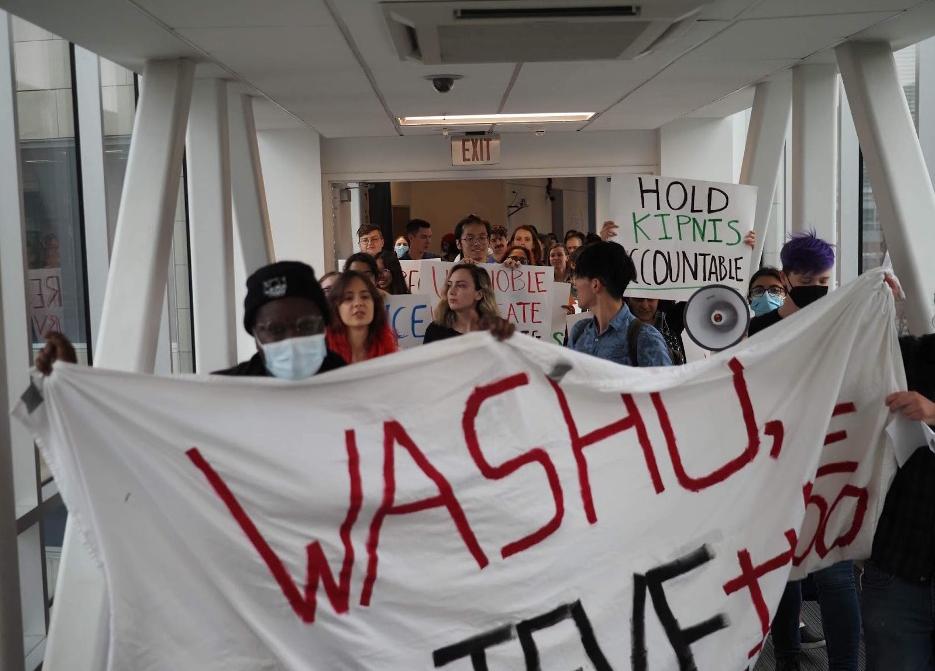
“There’s an event here,” he said, as chanting continued from the group. “You’re not gonna drop the banner.”
Despite Manley’s protest, attendees continued to the balcony and dropped their banner. They remained there for about 2 minutes before turning around and leaving calmly. As they walked back down the hallway, Manley called for backup officers, saying, “Things are getting unruly.”
Organizers began leading the group towards elevators that went to administrative offices. Once the group got to the elevators Manley met up with Response Officers Mark Decker and Johnathan Blanchard. Manley and Blanchard
stood in front of the elevators, and agitation between the two parties began to fester.
“The deans represent us, and they should be able to hear what the students have to say,” one attendee shouted.
“You’re not going up there,” Manley told the group. “This is a place of business,” he continued in response.
“I recommend you go that way quickly,” he said, gesturing behind the group after a back-andforth between himself and several attendees.
“What’s gonna happen if we don’t go that way?” Moffa asked, calmly.
After a pause, Manley said, “I would expect handcuffs,” yielding scoffs and sighs of resignation from the group. Several attendees left the event at this point, feeling threatened by Manley’s words. Others broke out into more chants.
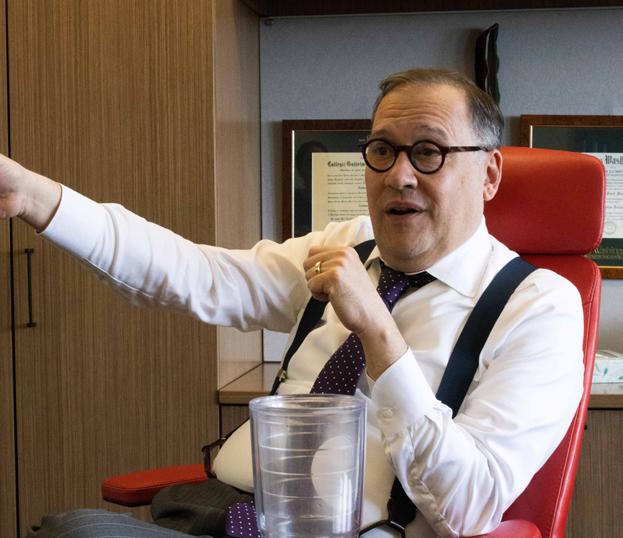
“We want to meet our deans!” they shouted. “Where are you to stop abusers?”
After a request to send three people up and continued refusal from Manley and the other officers, WUGWU organizers asked the attendees to disperse. Manley remained by the entranceway to the elevators as attendees walked away.
When asked by StudLife what rule stated that students could not visit administrative offices, Manley said, “We’re not gonna do that right now.” When asked to clarify, he turned away and went to speak with other officers. he did not respond to an email request for comment.
“They wouldn’t meet with us even though all we’re asking for is peanuts,” Moffa said as they walked away. “This isn’t a secret. WashU knows about abuses. It’s not hard to do the right thing, and they’re choosing to protect powerful men.”
After the opening, attendees stood outside the store, tried the ice cream, and watched the student band, Non-Euclidean Geometry, perform.
The ice cream comes in sizes mini, regular, and large, with additional mix-ins available depending on the size. Prices range from $5.50 for a mini ice cream to $8.60 for a large, and students can pay with Bear Bucks, credit or debit cards, or Apple Pay.
Lieber said that the existing menu is subject to change and that student suggestions would guide the future of the creamery.
“A lot of people are upset that there’s no vegan flavor,” Lieber said. “We’ll do that. We’ll get a chocolate base if people want. I’ll literally do whatever people want.”
Campus Creamery is the newest of the University’s StEP businesses, a University loan program in the Skandalaris Center that provides students loans of up to $10,000 to start their own business on the South 40.
Martin said that he supports the StEP initiatives and the students who participate because he believes it benefits the University.
“I think opportunities for students to be able to start businesses, to serve students, and to locate it here on the South 40 is a real, positive educational experience for the students who are involved,” Martin said. “I think it can really add a lot to our community.”
First-year Simon Horowitz expressed similar sentiments about entrepreneurial opportunities at WashU.
“I think it’s cool that we can take an idea and put it into expression through [StEP],” Bridge said. “The reception
SEE ICE CREAM, PAGE 3
and also address whether the University is changing how it investigates and handles cases of sexual misconduct?
Martin: I can’t speak about any particular investigation. What I can say is that we take these allegations very seriously, we do comprehensive investigations, and depending on where the facts lead us, we sanction individuals appropriately. But we can’t provide transparency in these situations for the simple reason that if any member of our community was accused of this type of behavior, they would want their privacy protected as well.
new concerns of academic integrity and adjust to the fact that many marketable skills can now be carried out for free by AI. How does the University plan to adjust its pedagogy in response to students using Chat GPT at school and entering a workforce that is being changed by these technologies?
our institutional values and commitment, this is at the top of the list.
Chancellor Andrew Martin sat down for an interview with Julia Robbins, the former Editor-in-Chief, on Tuesday, April 4 for his first Q & A with Student Life since 2018. Questions touched on the University’s investments in fossil fuels, how Chat GPT will affect the future of academia, and the University’s responses to sexual assault allegations. The Q & A has been edited for length and clarity.
Student Life: Politico reported in 2021 that ten of the 20 largest college and university endowments had fully or partially divested from fossil fuels. Why has WashU not divested from fossil fuels and is there any plan to do so in the coming years?
Andrew Martin: This was a decision made by the board of the Washington University Investment Management Company on which I serve ex officio that we are not going to do what are called either positive screens or negative screens with regard to our endowment. So rather than saying we’re not going to invest in a particular area, or we’re going to invest a lot in another area, we’re going to look at every investment on its merits.
SL: Can you respond to many students’ call that the leaders in our communities
should be making decisions that are in the best interest of preserving the Earth for the young people who will be living in it longer?
Martin: Your question is predicated on the assertion that where universities intentionally choose to invest their assets using negative screening is going to have a benefit on the environment. I think that that’s a pretty tenuous causal chain. I think the question is, what is the University doing to help the environment and sustainability? And on that front, we have made massive investments over the last 25 years.
SL: Jon A. Shields, a professor of government at Claremont McKenna College, wrote an opinion piece in the New York Times that argued that the vacuum of conservative thought taught through an intellectual lens on campuses can lead conservative students to lean on alt-right leaders. How, if at all, do you think administrators and professors at institutions of higher education, including WashU, should look to develop more access to intellectual conservative thought?
Martin: I haven’t had a chance to read the article so I can’t comment on it directly. But as we think about our institutional values, it’s all about engaging with complex issues of the day through multiple perspectives. I haven’t done any survey of the curriculum, so I don’t know if
Diébédo Francis Kéré, the first African laureate of the Pritzker Architecture Prize, presented his architectural works and encouraged students to use their education for positive change when he spoke as part of Sam Fox School’s Public Lecture Series, April 1.
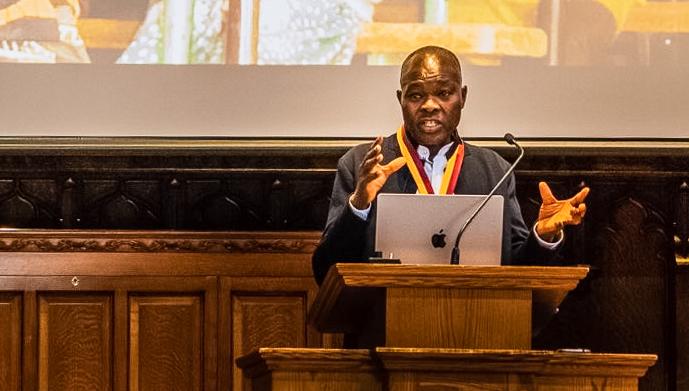
Kéré attended the Technical University of Berlin, and has since received many awards in architecture. He is also a visiting professor at several prestigious institutions in the United States and Switzerland. His work, frequently created under material scarcity, is renowned for its ability to be both elegant and socially conscious, while also connected closely to his home community in
there’s not enough exposure to these classical conservative ideas. [However,] it would certainly be in our institution’s interest for our faculty to lead engagement with our students on these particular issues as intellectual exploration.
SL: Do you think it would be worth surveying courses to see what exposure exists already for these ideas and potentially seek out professors who can provide insight into traditional conservatism?
Martin: The curriculum is owned by the faculty, and this is a really important tenet of shared governance. One of the things I can’t do as Chancellor is say, ‘we’re gonna have a requirement to do X, or you can’t teach that,’ and that’s a good thing. It’s important that we invest that power with the faculty. I do think it would be healthy for our faculty to look at the curriculum and see whether or not the curriculum was meeting the needs of the students.
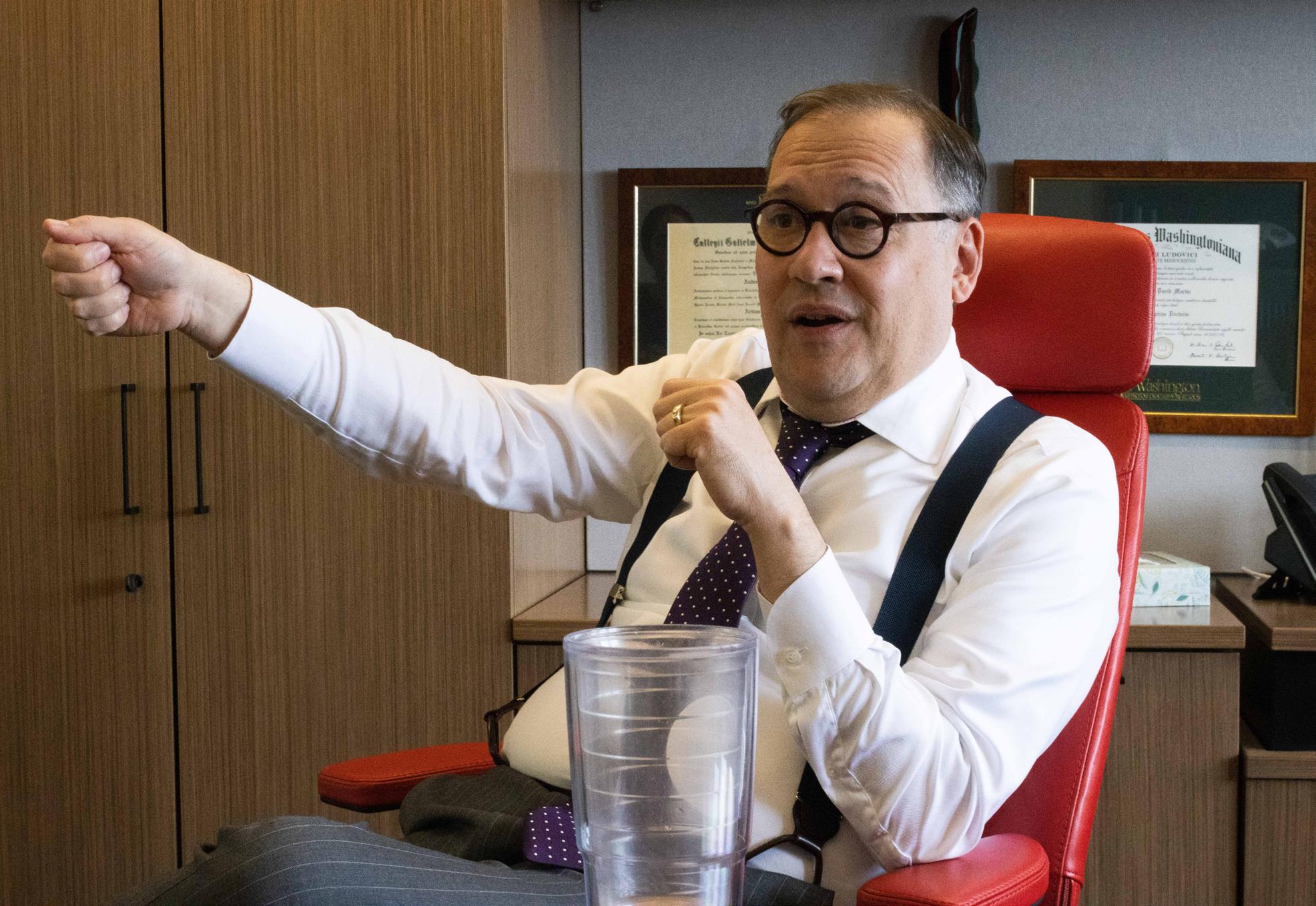
SL: The WashU Undergraduate and Graduate Workers Union protested several days ago against the University’s handling of sexual misconduct allegations against two different professors at the University. WUGWU demanded greater transparency from the University in how it investigates cases of sexual misconduct and demanded an external investigation for the allegations. Can you provide a response to their demands
SL: Is the University changing how it handles future investigations of sexual misconduct?
Martin: Every case is different, and we are going through a process both on the medical campus and on the Danforth campus to look at the way in which we are investigating these cases when it involves faculty members and trainees in laboratories in particular. At present we haven’t changed anything that we’re doing, which isn’t to say that we’re not going to change how things are done.
SL: Just a few years ago, many WashU students could live on campus for all four years if they wanted to. Now only two years of on campus housing are guaranteed, is the University looking to expand its on-campus residential life offerings?
Martin: Yes. We are exploring ways in which we can continue to grow and diversify our housing portfolio. It is non trivial for two reasons. One, we’re geographically constrained. But we also have to work with our governmental partners and particularly Clayton with regard to the South 40 and University City with some of the housing that we have that’s a little bit off campus.
SL: Are there talks of the University purchasing land that Fontbonne currently owns?
Martin: No.
SL: Chat GPT has shown the world that the future of academia will need to meet
Martin: This is an issue that we are having lots of active conversations about. I think there are two issues. The first is the academic integrity issue, which in a sense, is a little bit easier. The academic community is going to define what’s appropriate and what’s not appropriate, just like we do with other tools. I think the bigger, more important conversation is how we are going to ensure that our students are able to harness AI for whatever it is they want to be doing, both academically and professionally and beyond. And we’re having those conversations in lots of different places, and it’s appropriately led by the academic leadership of the University. But we’re certainly not burying our heads in the sand and saying ‘we’re going to do things like we’ve always done them’ because that’s not where the world is going.
SL: Student Life reported in 2018 on the challenges that people with physical disabilities face in navigating certain buildings on campus and other parts of the campus’ infrastructure. What progress has the University made in the years since to ameliorate these issues, and are there plans to make the campus more accessible for people with physical disabilities in the years to come.
Martin: I can’t speak about the gradient of how things have changed over the last five years, but I do know that we are deeply committed to ensuring that the campus is accessible. I certainly know one challenging space is the Women’s building, which is something that is on our docket to address. The problem is we have to decant what is in the Women’s building someplace else before we can do the Women’s building, and we don’t have a lot of spaces sitting around right now. But in terms of
SL: In your 2018 interview with StudLife, you posed the following question as something you wanted to address in your time as Chancellor: “how do we ensure that students who are learning incredibly valuable areas of study like philosophy and classics and sociology are able to connect their undergraduate education with their goals and aspirations, some of which of course have to do with getting a job.”
Can you comment on what progress the University has made so far and what you hope to accomplish in the coming years in this regard?
Martin: I think the area where we’ve made the biggest progress is moving to a model where we have a single career center. This is important for two reasons. [The first is] I want every one of our students to be able to access the full set of resources we have at the University. The system we had before where things were siloed by school was limiting to some of our students. And the second driver had to do with employers. Employers are interested in talent across the spectrum, and a centralized career center will let students from all four of our undergraduate schools have a conversation with someone who can say ‘these are the types of positions that you can get, maybe some things you need to do to augment, and here are some relationships that can help you get on your way.’
SL: What are some of the challenges you foresee the University facing in the coming years?
Martin: I think the biggest challenge facing the University is the way in which we portray ourselves and tell our story about what we’re doing to serve the public. I’m deeply committed to the idea that Washington University has public service as its core mission. But we need to do a better job making sure that the investment we’re making in our broader community, both here in St. Louis and in the state of Missouri, is better understood.
Burkina Faso.
Professor Adrienne Davis introduced Kéré, saying that “his vision for the world is one to which Washington University also aspires, a future that is sustainable, socially just, and in which we can all find ourselves in a strong and inspired community.”
Kéré began by acknowledging the help he received from his home community, teachers, and students in the past.
“I love colors, I love natural colors [in buildings] … but what I love the most is people, is you guys,” Kéré said. “I tried to use what I can do for the benefit of my people.”
He spoke about his own educational experience in Burkina Faso, having to travel nearly 25 miles to the next village to attend a school with almost no lighting and
poor ventilation. Kéré emphasized the significance of education, saying that he would not be here without it. He considered studying in Berlin a “privilege” and admitted that he has never considered “being an architect here in the West.” Instead, he wished to use his education to empower his community and country.
“Everything is possible if you have access to education,” Kéré said. “I was
bringing light to places where there are no opportunities and education.”
In an effort to create an educational space for the children of his village, Kéré designed the Gando Primary School, constructed by locals mostly from the clay abundant in the region.
Recounting his experience overseeing the construction of Lycée Schorge, a secondary school in Koudougou, Burkina Faso, Kéré highlighted the
participation of women in the process of construction.
“You can see that women gather … in a profession that is not seen as women’s domain,” Kéré said, showing a photo of the wooden chairs that the women designed and created for the Lycée.
Kéré also commented on the necessity of preserving the cultural heritage, expressed in different colors and elements, that is central to African identity.
The Benin National Assembly, a recent project under construction in PortoNovo, Republic of Benin, embodies this ideal. The structure pays homage to palaver trees, used by communities across West Africa as venues for hosting communal gatherings.
Usually, the Occidental, Greco-Roman style is the norm for successful architecture in Africa.
Architects are considered accomplished when their buildings resemble those found in the U.S., France, or Britain. Kéré wanted to be the exception.
“I was hoping to escape [from such practice] … let me build a structure that values nature, a structure that people can approach,” Kéré said.
By thinking outside of the convention, Kéré “was not just coping, but inspiring, to get fresh ideas relevant to what Africa is.”
Similarly, his Serpentine Pavilion in London adopted cultural elements that are native to Burkina Faso: one of them is the use of a deep blue façade, the color that represents the concepts of “celebration and optimism” in West Africa, according to Kéré.
During the final session of the semester, Student Union (SU) Treasury unanimously approved Budget Committee funding for next year and allocated $15,398.55 to five student groups for social events, new equipment, and travel funds.
Treasury send-offs
Junior Mishka Narasimhan, Speaker of the Treasury, started the final meeting by giving kudos to the three Treasury representatives who will not be returning to SU in the fall after their terms ended this semester. Sophomores Robbie Mazer, Kenny Duran, and Pedro Morales each served one term, which lasts an entire academic year, and have chosen not to run for re-election.
In a follow-up interview with Student Life, Duran
explained that he is not running for re-election because he plans on studying abroad, but that he has enjoyed his time as a representative.
“Since I was appointed last spring, my term in Treasury has been nothing short of a collaborative and memorable experience,” Duran said.
“Working closely with my fellow reps has allowed me to grow in different areas, so saying goodbye to them in this final session was bittersweet.”
Morales echoed similar sentiments in a follow-up interview with Student Life, describing how much he enjoyed working with the other members.
“Working in SU has been one of the most rewarding experiences of my life,” Morales said. “It hasn’t been easy — SU is a big responsibility. But what kept me going was the amazing and intelligent people I had the privilege to work with each session — especially Mishka Narasimhan, Sadie Karp, [and]
Emily Chen — who each put in an excessive amount of work to make sure everything went smoothly.”
Narasimhan continued with a send-off for senior Max Roitblat, Vice President of Finance, who will be graduating this spring after being involved with SU for all four years of his time at WashU.
During the fall semester of his freshman year, Roitblat was appointed as a Treasury representative, a role that he served in for two more semesters before being internally elected Budget Committee Chair during the spring semester of his sophomore year. He held that position until he became Speaker of the Treasury as a junior, before eventually being elected as Vice President of Finance for his senior year.
Sophomore Sadie Karp, Budget Committee Chair, stated that she has enjoyed her time working with Roitblat and appreciates his help throughout her time in
President | Emily Chen
Executive Vice President | Hussein Amuri
Vice President of Finance | Mishka Narasimhan
Vice President of Programming | Abby Sode
Vice President of Engagement | Andrew de las Alas
Senators | Sahil Soni, Ashton Lee, Sarah Aliche, Shriya Pendyala, Omar Abelmoity, Ella Scott, Natalia Leon Diaz, Erin Ritter
Treasury Representatives | Sadie Karp, Christine Ling, Leila Asadi, Oli Zhang, Gisela Liu, Sam Hogan, Zubin Rekhi, Aryan Pradhan, Justin Kouch, Neil Chavan, Jonah Satyr
from students shows how much we want each other to succeed.”
Since Lieber began working with the Skandalaris Center over a year ago, he has collaborated with various other business partners, including an architecture firm, a construction team, and an engineering team. He also said that he has already hired some employees, but plans to employ more people in the future.
“I have my employees now which is awesome,” Lieber said. “They’re helping me with scooping, and I’ll allocate positions to them because it’s been hard over the last couple of months. I definitely could use a little more help.”
At the end of the day, however, Lieber said that the business was the result of his own efforts.
“I don’t have a team,” Lieber said. “It’s pretty much me.”
Other community members expressed that the Campus Creamery
VOLUME 144, NO. 20
from page 1
will add positively to the culture of WashU and, specifically, to the South 40. A particular aspect of the Campus Creamery that excited students, such as first-year Lauren Speicher, is its late-night hours.
“I love going to Olin to study late at night,” Speicher said. “I think it’s really cool that it’s gonna be open until 2 a.m. BD closes at 12, so it’s gonna be a late-night, poststudying snack.”
Lieber shared their sentiments and said that he is optimistic that Campus Creamery will succeed.
“There will be plenty of people who want ice cream,” Lieber said. “There’s not much else open. We’re open until 2 on weekends. It’ll be popular.”
Lieber is not only confident about the future of Campus Creamery on the South 40, but he also hopes to take it beyond WashU after he graduates. He said that StEP requires
Treasury.
“He’s just the best resource you’ll ever meet,” Karp said. “He is so knowledgeable and helpful — he has definitely shaped me into the Treasury representative that I’ve become, which I’m really grateful for. I’m really sad to be losing Max. I’ve spent a lot of time working with him.”
Sophomore Leena Rai, Treasury representative, spoke about Roitblat’s impact on SU. “You have such a stressful job, and you've managed to infuse some joy into the office space in these meetings,” Rai said. “I know that I haven’t been here that long, but I think I've been here long enough to see what an impact you've had. We’ll miss you.”
Roitblat described how SU — and Treasury in particular — have hugely impacted his college experience.
“I’ve been here since it was first possible for me to be.
I was appointed my freshman fall, and I’ve been in SU all the way since,” Roitblat said.
“I love getting to work with you all in Treasury. I loved serving in Treasury and, of course, working with all the student groups. That stuff makes it fun and enjoyable to keep pushing through all of the challenges, so I will definitely miss this.”
Budget Committee
Treasury representa-
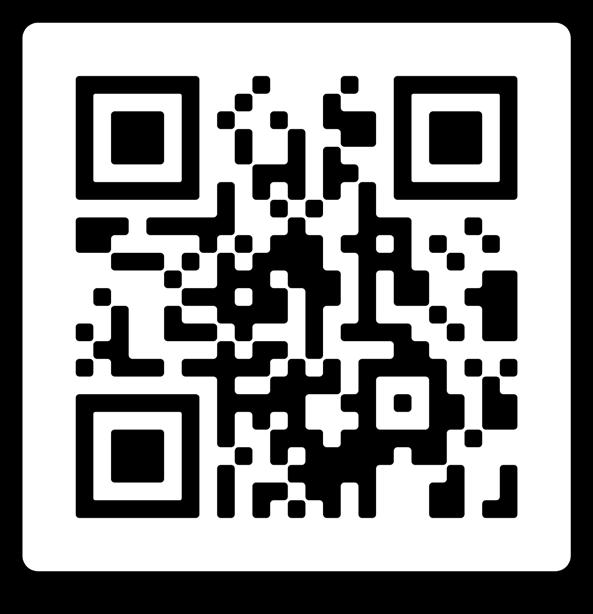
tives voted unanimously to approve the Budget Committee funding to allocate funds for 194 student groups for next school year. Each year, the Budget Committee creates a budget to allocate funds from the same pool that Treasury appeals draw from, allowing groups to receive money at the beginning of the year for funds that they know they will need ahead of time.
In a follow-up interview with Student Life, Karp explained the reasoning behind having the Budget Committee to look at budgets
now.
“The purpose of doing it this way is twofold,” Karp said. “First is to budget for events that happen early in the year, around the beginning of September, so [that] clubs have the funds to pay for those events. The second reason is to fund large-scale or high-priority events that [might] happen later in the semester to ensure they get funding, so if the appeals pot were to be emptied earlier, there would still be money for the important events.” Budget Committee only looked at budget submissions from groups designated as Category One on Treasury’s

students to sell their shares when they graduate to keep StEP businesses in student ownership, but that he might want to do things differently.
“There’s a certain limitation on StEP programs,” Lieber said. “Where, when you graduate, you’re required to sell. My long-term goal is to take this to other universities and have this expand into something bigger that started at WashU,” Lieber said.
Martin said along with appreciating the work that went into creating the Campus Creamery, he liked the ice cream itself.
“The ice cream is very, very good,” Martin said. “It’s sort of like a concrete, like we do here in St. Louis.”
First-year Chris Bridge enjoyed the event and the broad appeal the Campus Creamery has.
“I mean,” Bridge said. “Who doesn’t like ice cream?”
On March 31, around 50 people — mostly students — gathered in the atrium of the Farrell Learning and Teaching Center on Washington University’s medical school campus. They held white signs and sheets painted in bright red lettering.
It may have not seemed momentous to an outsider, but the protest signified Washington University Graduate Workers Union’s (WUGWU) first return to public activism on campus since 2019, when members occupied Brookings Quad to demand an increase of wages to $15 per hour for University employees.
The group — which is not officially recognized as a union and therefore cannot collectively bargain with WashU — was founded in 2016. Four years and a pandemic later, momentum and membership fizzled out. WUGWU has just begun its marked return to activism in the last six months, in part fueled by increased interest from WashU medical students after an alleged sexual harassment incident in a University lab came to light in December of 2022.
Marc Blanc, a PhD candidate in English and American literature, joined WUGWU the day of his graduate student orientation in August of 2018. At the time, the organization was actively recruiting members, passing out flyers and signup sheets to new graduate students.
“I already believed in unions and had belonged to a union before, so I signed up pretty eagerly,” Blanc said. Soon, he was heading the communications committee, making social media posts about upcoming events.
As a core member of WUGWU, which claimed over 200 signups, Blanc said he volunteered hours of his time to the organization, being one of the core 6-to-12 people that routinely showed up to weekly meetings.
“There [were] several times that first year I was like, ‘am I using my time wisely? Should I be studying?’ It was quite a time commitment,” Blanc said.
Blanc added that
involvement spanned across all departments on the Danforth campus.
“It was quite cross-disciplinary,” he said. “There [were] as many scientists as there were humanities people as there were social scientists. It was a really wonderful mixing of minds and energy.”
The most dedicated to WUGWU, however, were the humanities students. Blanc suspected a few reasons. One, he said, was that hard science students were better-compensated for their work and were likely less motivated to advocate for higher stipends. Additionally, Blanc said, humanities graduate students are generally more prone to activism.
“This is not scientific at all,” he said. “But the people who choose this study — English or history — have already kind of voiced skepticism of the workaday world, and are more prone to try to agitate change.”
Yet when COVID-19 prompted a mass switchover from in-person meetings to Zoom ones, activity across all disciplines dropped off rapidly. Core leaders began to graduate, and inperson recruitment — the way Blanc was sucked in — wasn’t possible.
Alejandro González, a second-year economics PhD student, joined WUGWU in 2021 after transferring from the University of Washington. For his first year and a half, meetings were on Zoom and it was clear that morale was low.
“I think the union…it's fair to say that it was in a state of disarray,” González said.
González said that in the summer of 2022, there was some stirring among WUGWU members to organize for higher stipend increases in light of rampant nation-wide inflation. However, by the time leadership began to consider the question, the University announced they would raise wages and the moment passed.
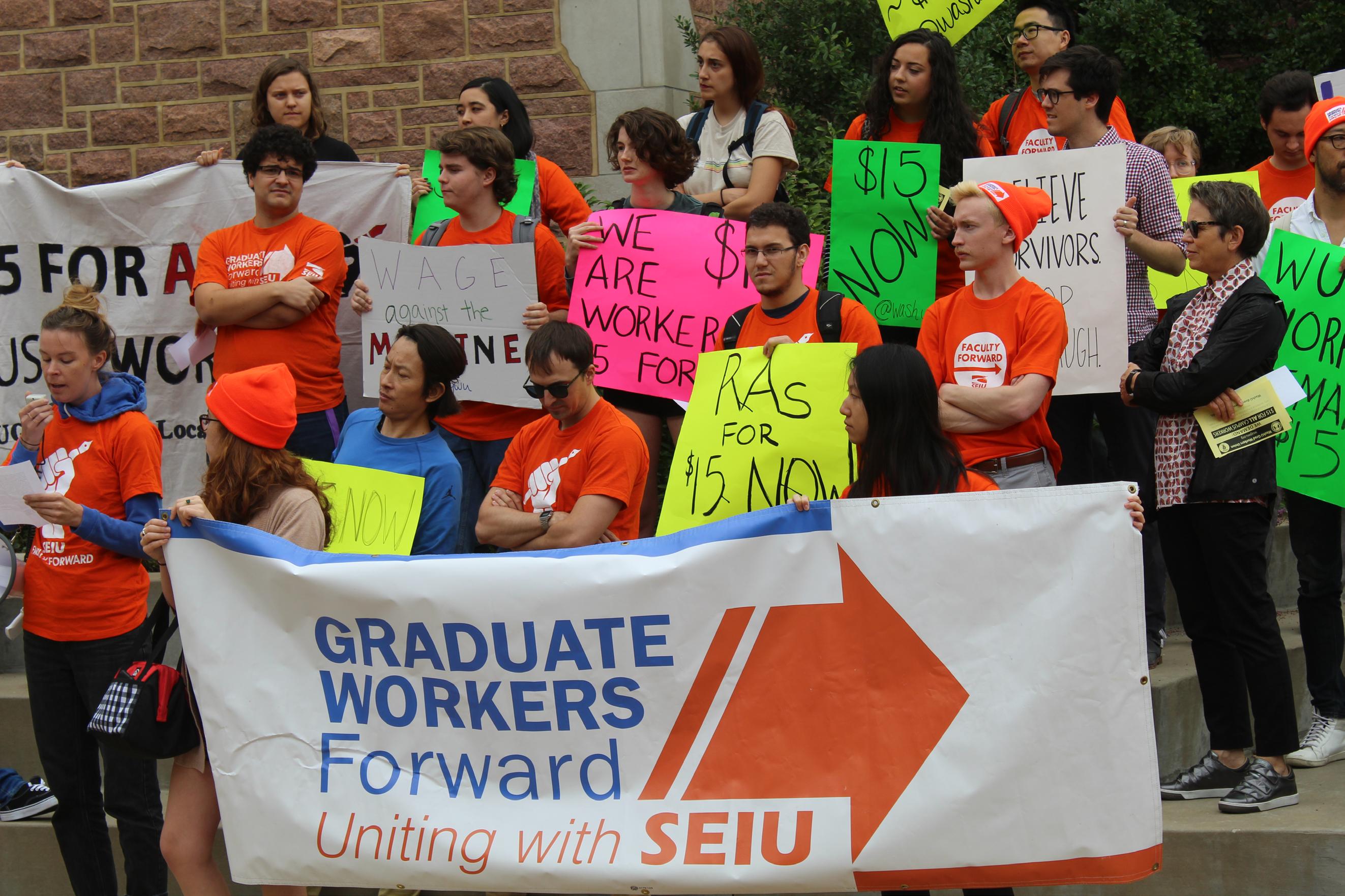
A meeting agenda document shared with Student Life by a former WUGWU member showed that fourto-seven people gathered on Zoom about every two weeks in the fall of 2022. After Nov. 21, 2022, no more meeting notes are
recorded until suddenly, in Jan. 2023, nearly three times as many members are listed as present. This came alongside paragraphs on paragraphs of action items and to-do lists. The WUGWU Instagram account shows a similar lull in on-campus activity during the past couple years. A post from June 2021 advertises a WUGWU park hangout, but no other posts appear until mid-Jan. 2023, notifying followers of the first meeting of the semester.
The notes in 2023 surround issues in reporting sexual harassment, as well as attempts to imagine a newer, tighter system to keep mandatory reporters accountable. Many reference the story reported by Student Life detailing how Lila, a PhD/MD student, was sexually harassed by a superior and ended up leaving the University after reporting to her higher-up that led to no immediate action.
Jamie Moffa, a sixthyear MD/PhD student, was one of a few WUGWU members that stuck through the Zoom era. They joined WUGWU in 2020 and was an active participant.
Moffa was one of a few members to meet with administrators in December of 2022 to ask for more stringent policies around mandatory reporting, including requesting
third-party arbitration and investigation when WashU faculty failed to report sexual misconduct cases to the Title IX office.
Moffa said they asked for probation for faculty that don’t follow mandatory reporting rules the first time, and making it a two-strike fireable offense. They also requested more transparency if a faculty member was under HR investigation.
Eva Aagaard, senior associate dean for education at the medical school, was one of the administrators that met with Moffa. She suggested over email that Student Life reach out to leaders of the Task Force on Climate and Culture, which was assembled on Dec. 16, 2022.
Dr. David Perlmutter, executive vice chancellor of medical affairs, announced that the Task Force would be created in response to “students, staff and faculty [who] have reminded us, in the anger and frustration they have expressed in response to recent events, that we have not done enough to be that place of inclusion and safety, that we have been far too comfortable in our excellence.”
Dr. Benjamin Garcia and Dr. Dineo Khabele, co-chairs of the task force, commented jointly to Student Life about WUGWU’s demands.
“We are actively seeking
input from students, trainees and faculty with the help of our outside consultant, Catalyst,” they wrote.
“We will certainly have more to say after we gather the data.”
Dineo and Khabele also pointed to existing rules for mandatory reporters.
“We already have policies in place at the School of Medicine regarding mandatory reporting and we have ongoing training/education around this.”
González isn’t optimistic about the task force. “It's another dump of money on an HR initiative that essentially conglomerates a lot of people to hear them out, and kind of do reports, but it does not address any of the issues that we have raised,” he said. “We're not asking for socialism here. We're just saying ‘enforce your current roles, be transparent to the University community.’”
Aagaard sent Moffa an email after their meeting that linked the same HR guidelines, but Moffa and other members of WUGWU still felt that current University policies were not strong enough.
“The policy about mandatory reporters…it's very unclear. And it was very unclear to any of us whether there were any repercussions for failing to do your duty as a mandatory reporter,” Moffa said.
Moffa said that this issue
felt symbolic of the problems that WUGWU had been attempting to address over the past few years –– primary investigators having unchecked power over graduate student workers, a lack of clear support systems for PhD students, and a fear of retaliation if one spoke out against a superior.
“[It] feels like kind of a culmination of a lot of the issues that are that we want to address from academia in a very tangible way,” Moffa said.
The issue of sexual harassment and reporting procedures has re-invigorated the organization, with an influx of medical student members, Blanc said. Though involvement isn’t yet up to pre-pandemic levels, he said leadership was “working on that.”
Next up, Blanc said, is organizing a vote to become an official collective bargaining unit for graduate workers on campus.
In order to pass the vote, WUGWU will need a simple majority in a graduate student worker body. In light of WUGWU’s recent activism, Blanc is optimistic that they’re well on their way to becoming a force for change on campus.
“More and more unions are winning their elections [at] universities across the country,” he said. “It's only a matter of time before it happens here.”
In-between, an annual pan-Asian mental health conference founded in 2019, will return to Washington University on April 8. The event will feature workshops and panels on topics such as Asian American family identity, suicide prevention, civic engagement, and neurodivergence, with speakers from WashU, the St. Louis community, and beyond.
In-between is the only student-run conference in the country that solely focuses on topics relating to Asian and Asian American mental health, according to club president
senior Vivien Huang. From 10 a.m. to 5 p.m. on Saturday, April 8, students can hear from speakers like Dr. Han Ren, a licensed clinical psychologist, TEDX speaker, and TikTok creator based in Austin, Texas; Kiki Gao, licensed social worker at Behavioral Health Response in St. Louis; Julia Ho, WashU alum and founder of Solidarity Economy STL; and Stephanie Hu, a Harvard University student and founder of the advocacy organization Dear Asian Youth.
Lunch from Corner 17, Thai Country Cafe, and Gokul Indian Restaurant will also be available to students who register for the conference. Through interactive
activities and speaker panels, the in-between team hopes that students will take advantage of a “space where [they] can talk about [their] life and form a community” while “get[ting] to understand [themselves] a little bit better,” sophomore Saish Satyal, a leader of in-between’s finance team, said.
Sophomore Reeya Joseph, who helped organize the finances and speaker outreach, said that the conference has something for everyone.
“It’s for everyone to talk about mental health at the end of the day,” Joseph said. “It’s really just about learning new information.”
Huang is excited to speak on the panel
Neurodivergence and Asian Identity.
“It’s a topic that I think is under-discussed in all racial populations, but especially the Asian American population. In general, a lot of females don’t get diagnosed or get diagnosed much later in life because the diagnostic criteria weren’t written with females in mind,” Huang said. “That is especially true in Asian populations because the model minority myth forces girls to hide their [neurodivergent] traits.”
Satyal and Joseph said they are particularly interested in the Asian American Family Identity discussion led by psychologist Thomas Kui.
“I think the speaker plans to talk about Asian
American identity and how you translate that into Western culture,” Joseph said. “I feel like it's relatable to a lot of young people who might be first or second or thirdgeneration who have gone through that [experience of] having an Asian American family but also having to transition into American culture.”
Satyal also highlighted the panel on Queerness and Asian Identity, led by Dr. Jacob Chacko from the Center for Diversity and Inclusion, Ahmar Ursani from the Career Center, and Dr. Han Ren.
“There’s not as much discussion of queer Asian identity, and I’m really excited about a panel that begins to explore that because there’s so much
intersectionality,” Satyal said.
Above all, the conference aims to raise awareness of mental health issues in the Asian American community.
“Asian Americans are the least likely group in the country to seek mental health support, and I think that that has a lot of different reasons: stigma, lack of knowledge and discussion in the community, and the fact that there’s not a lot of Asian therapists or psychiatrists,” Huang said. “in-between attacks that from two different angles, bringing in Asians who work in mental health and are passionate about mental health and then promoting that dialogue.”
Bowles Plaza, known for its tranquil ambiance, is home to a secret past that most students are unaware of. Hidden deep underground, there once was a vibrant on-campus pub that served as a popular social hub for hundreds of students. The pub's lively atmosphere, characterized by the clinking of glasses and the boisterous laughter of young adults, was a testament to its success in bringing together the campus community. Despite being a
well-kept secret, the pub's legacy continues to live on in the memories of those who were fortunate enough to experience its charm.
The Rathskeller — originally known as the Umrathskeller, due to its proximity to Umrath Hall — was once a beloved establishment at WashU. Opening in the Fall of 1975, “The Rat,” as it affectionately became known, quickly became a hotspot for events, tasty lunches, and social happenings. As a staple of campus culture, it provided a space for students to socialize over burgers and
indulge in affordable beer.
"Thursdays at the Rat" was a weekly event where the restaurant would extend its hours past lunchtime to play a significant role in WashU's bustling nightlife scene. The event consistently drew crowds that far exceeded the capacity limits of the space. In fact, a 2001 article sourced from Student Life’s Archive indicates that over 800 students would regularly attend the event, which far surpassed its maximum capacity of 310 people. Despite the overcrowding, "Thursdays at the Rat" remained a popular tradition among students, further solidifying the Rathskeller's place in
Despite its popularity, the Missouri Liquor Control Board revoked the restaurant’s liquor license in late 2001 due to an investigation into underage drinking. By spring of 2003, attendance of its weekly Thursdaynight gatherings had fallen so drastically that event
sales dropped below $10.
“The Rat'' remained open for lunch-hour operations but closed shortly after, before eventually being renovated and turned into office spaces.
While the beloved campus hotspot closed its doors some time ago, the possibility of its revival has gained attention, particularly considering the fact that the university’s alcohol license has been restored, and alcoholic beverages are served at Ibby's and a pub in the Knight center.
“The fact that we have a liquor license at Ibby’s means that could be a site for expansion to a different kind of venue,” Dean of Students Rob Wild said. Even so, this new expansion wouldn’t look exactly like “The Rat.”
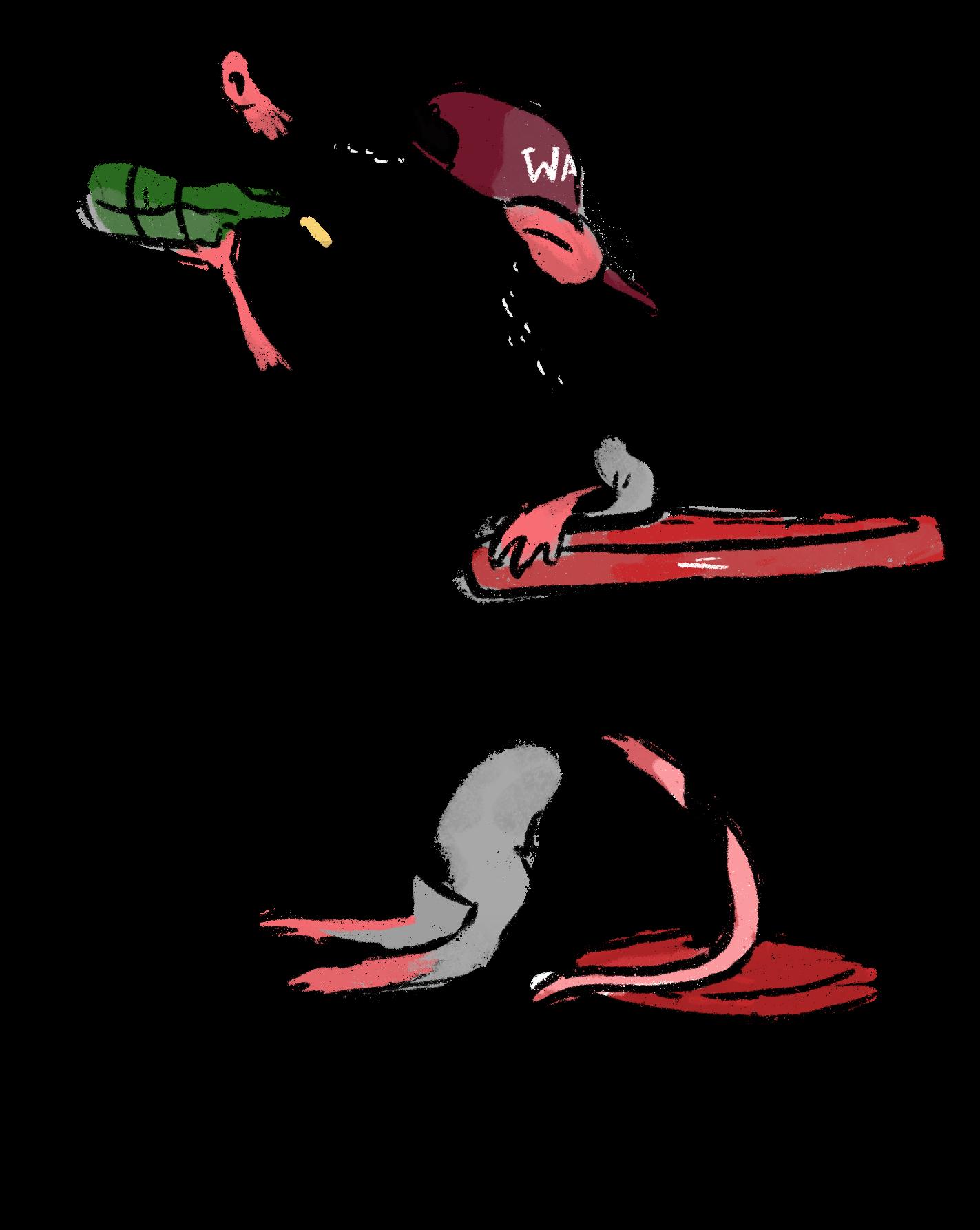

“The Rat wouldn't have been a good space anyway — because of the size of our student body now,” Wild asserted. Since 2003, the size of the student body has swelled to approximately 8000 undergraduates. “We're exploring it and whether we could create a couple of spaces where alcohol could be served legally, and we can provide that kind of venue again.”
A student-driven committee dedicated to examining space allocation is evaluating the prospect of developing a possible nightlife site. “We've [administrators] asked them, and they're in year one of a three-year planning process to look at the concept of social space and what would bring people together. From my perspective, as the Dean of Students, I think if the administration creates the

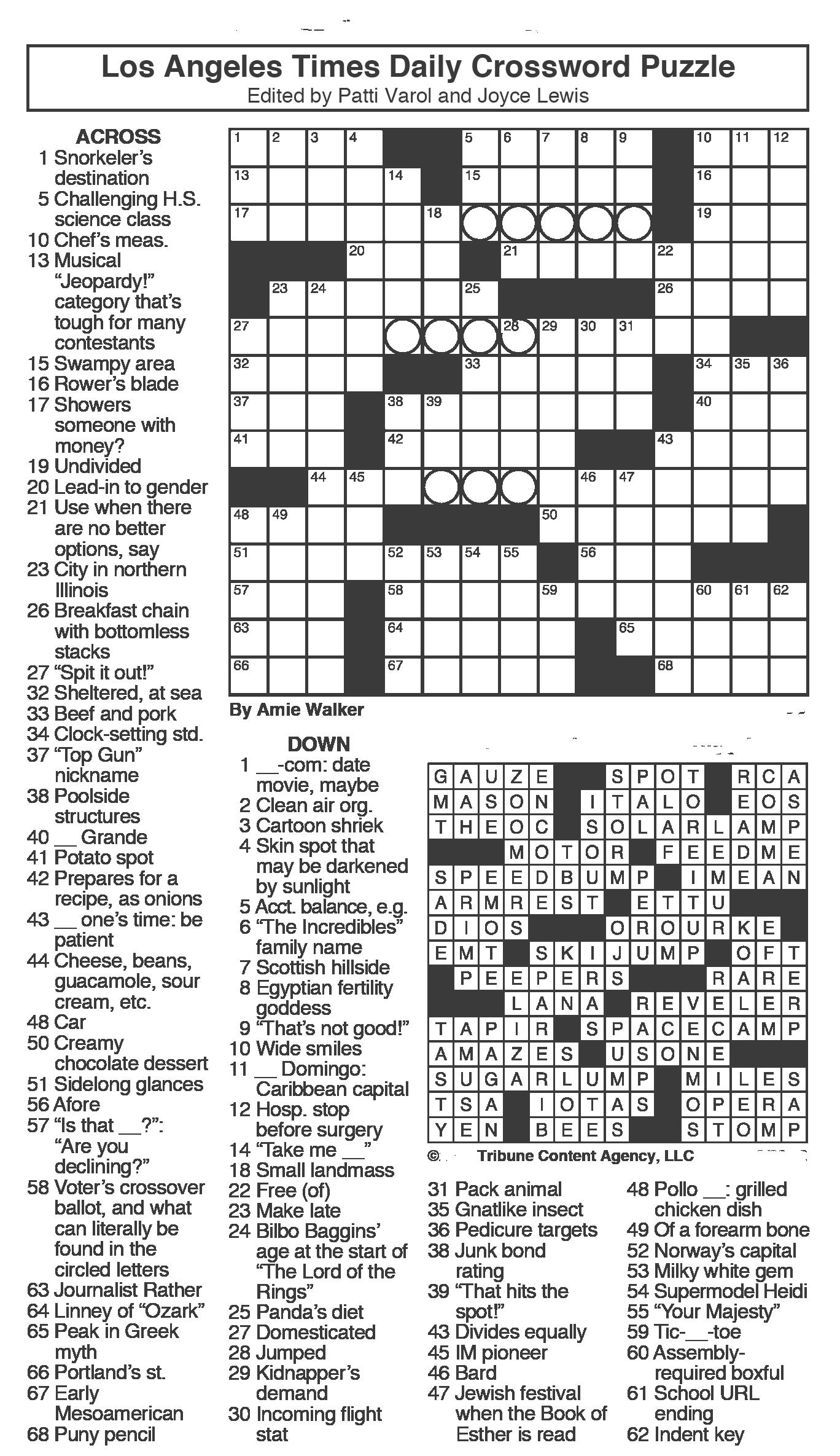
space, it'll be less successful than if it's a student-driven space,” Wild stated.
A poll conducted by Student Life on March 29 posing the question, ‘Would you be in favor of WashU establishing an on-campus bar/concert venue for upperclassmen and grad students?’ received an overwhelming response. Over 93% of the 138 respondents favored the concept, indicating a strong desire for an on-campus nightlife venue and a drive to create a space dedicated to facilitating social activities. “I think the pendulum has swung so that there is less social life on campus, certainly. And so I think there's a question about whether we can find a balance and allow more social activity on campus.” Wild said.
Some peer institutions across the nation have successfully run on-campus venues similar to the historic Rathskeller. “There are other campuses that have spaces like this — in fact, some colleagues of mine and I visited Duke University in the fall, and they have in their student center two different bar spaces that they run, and they are able to run [them] safely and effectively. There are universities that are doing it better than us. Absolutely. I think we can find that spot,” said Wild.
"The Rat" may never return, but its memory and legacy will continue to hold a special place in the University's history, and a future successor may one day restore its central role on campus.
BY TUESDAY HADDENKERE from page 2
Kéré’s used his ingenuity to design the Léo Surgical and Health Centre. Since there was a significant lack of materials in the area, he chose to construct it entirely out of clay, and added open spaces that could be illuminated by natural light so that the complex would not be seen as dull.
“This is my laboratory … a gift to my people,” he said. The presentation ended with a standing ovation.
Orion Strayer, a junior studying architecture at the Sam Fox School, has admired Kéré’s works for a long time and said that he was very inspired by the talk.
“I knew about Kéré before because I did one project analyzing his works in my sophomore year of architecture, and I think at that point, it was one of the most beautiful and socially effective works of architecture that I have seen,” Strayer said. “I was looking at Lycée Schorge, and the use of natural material, combined with the practicality of the structure — it’s simple and elegant and beautiful, and creates another experience for students.”
Strayer also said that Kéré’s talk helped him realize why architects are needed in our society. He believes that an architect should be the “caring human being on the other end” that designs buildings with love.
“If you love the people who will live in the building, then when those people enter that building, they will feel that love — for all of Kéré’s work, you can really feel that love, and that is the kind of architecture that I want to do,” Strayer said.
SPONSORED BY:


As we speed toward the end of the semester, our staff members have looked back on the past 365 days or so of pop culture fodder and found ourselves trapped between wistful nostalgia and embarrassed cynicism. It’s been a bad run for the Harries: Harry Styles had a baffling blockbuster debut, while Prince Harry royally overshared in a new and wholly unsolicited memoir. Everyone suddenly decided to care about nepotism. Austin Butler subsumed the ghost of Elvis, and Ariana DeBose burst into public consciousness in a blaze of glory. Then was the wave of infidelity, Leonardo Di Caprio’s alarming track record and, of course, the downfall of the wife guys.
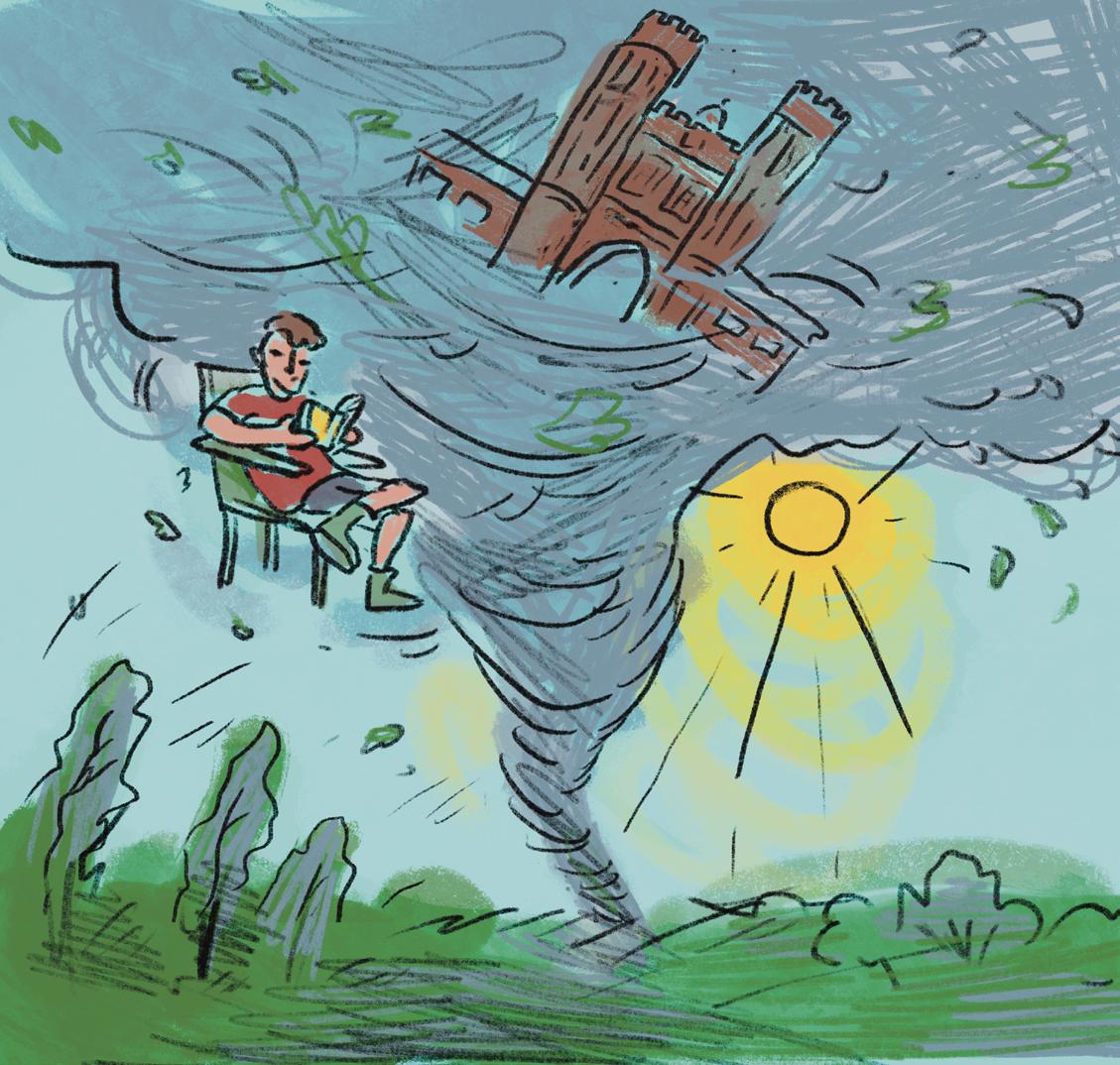
Only one thing can be said for sure: we know a little too much about each other, and far too much
about the multi-millionaires who appear in our media. But don’t fret: that won’t stop us — or you — from occasionally leaning into the voyeuristic delight of a public spectacle. In that spirit, join us on a tour of second-hand embarrassment: here are some of our favorite salacious pop culture moments from the past year.
Try Fidelity

In the fall of 2022, it was uncovered that “wife guy” Ned Fulmer had been having a “consensual workplace relationship.” (I doubt his wife gave consent to this, but I digress.) A cheating scandal is bad enough, but it’s even worse when the adulterer seems to actually love his wife. If guys who like their wives cheat, what about the rest?
It is important to remember in times like these that not all men cheat on their
wives; some cheat on their girlfriends instead (Hey, Khloe and Tristan, how are the kids?). What happened to waiting until marriage? At least Fulmer’s coworkers were quick to cut him out of the company. If every organization fired their cheating employees, I can only imagine what would happen to our police enforcement agencies. How would we go on? Wait, maybe I’m onto something here…
—Mia Burkholder, Contributing Writer
Nick’s Cannon doesn’t shoot blanks

How did we get here? As of December 2022, Nick Cannon’s children can play a formal game of basketball against each other. And not everyone needs to be on the court — each team can have a benchwarmer. In general, I’m an advocate for knowing less
about everyone, celebrities least of all, but morbid curiosity and self-loathing have led me to ask: when does it end? Surely we can put a stop to him? At what point do we get the authorities involved? When TLC (The Learning Channel, may I remind you) inevitably chases them down and puts them all in a house together for a reality TV show, will that be the last straw for my sanity?
—Jamila Dawkins, Staff Writer Adam’s Levine His Wife
Don’t get me wrong, I feel terrible for Adam Levine’s family, especially his wife, upon the exposure of his flirty DMs with other women. However, it's easy to forget that what he was doing was wrong because of the infidelity when his wording and choice phrases were so criminally
cringy. It is clear that his search history was “other words for really cool,” and ultimately decided on “absurd.” Besides the incredibly brainless phrases like “I may need to see that booty” and “I’d take it [the aforementioned booty] to dinner and whisper sweet nothings to it,” we get to see him use cusswords for the first time! “Holy f*cking f*ck”! I imagine these DMs going down in history like an ancient transcript.
—Gracie Hime, Chief of CopyLeonardo Di Age Cap(rio)
The fall of 2022 also resurfaced (via a Reddit graphic) the fact that, at least publicly, the 48-year old Leonardo DiCaprio has never dated someone over the age of 25. Fun fact: the brain doesn’t fully develop until age 25,
a quite troubling detail in relation to Leonardo DiCaprio’s apparent age cap requirement. Leonardo DiCaprio’s dating history cannot be separated from our gendered double standards for getting old (if you can even consider being 25 as getting old) as well as conversations surrounding power dynamics in relationships, but I’ll let my gender studies brain rest for the moment. And while discussions have centered around the idea of Leonardo DiCaprio breaking up with his girlfriends once they reach 25, I quite enjoy the opposite possibility — that the day the brain fully develops is also the day that one wakes up and decides it’s time to break Leo’s heart.
—Reilly Brady, Managing Forum Editor
Maybe you read “The Pearl” in seventh grade and vowed to never read a school-mandated book again. Maybe it was “Moby Dick” in college. Either way, it’s all the more reason to extend your nonschool-mandated reading repertoire, especially if your years of required readings are coming to a close. As graduation approaches for the Class of ‘23 and the Class of ‘27 prepares to join us in the fall, reflecting on what we have learned is a vital part of our educational experience. In this list, I’ve compiled some of the books that I feel have been the most
transformative and impactful for me so far, largely because they cause me to either reflect on my past or contemplate my future. So whether you are graduating in May or getting ready to move in this fall, here are the books that I think you should read before you graduate.
“Kindred” by Octavia Butler
“Kindred” is a terrifying and gut-wrenching “Magic Tree House” for adults. I read the entire book in one sitting after reading Butler’s short story “Speech Sounds” in class, and I bought another of her books, “Parable of the Sower,” as soon as I had finished. If
that’s not enough, Octavia Butler is a master of speculative fiction, visionary of Afrofuturism, and genuine genius. For everyone, but especially fans of “Beloved,” “The Handmaid’s Tale,” and “Slaughterhouse-Five.”
“The Godfather” by Mario Puzo
“The Godfather” film is an undisputed cinematic masterpiece, yet it is often forgotten that The Godfather novel, its predecessor, is a feat of media as well. Even if you aren’t a mafia aficionado, this novel contains one of the best death scenes in literature and some incredibly quotable dialogue. For everyone, but especially fans of “Wiseguy,” “The Da
Vinci Code,” and, of course, Francis Ford Coppola’s “The Godfather.”
“The Virgin Suicides” by Jeffrey Eugenides
This book is the sole reason I like to dramatically cry on my birthdays. A tragic exploration of femininity, girlhood, and growing up and a devastating reminder of how impossible it is to truly understand someone else’s perspective. Told by the boys next door, “The Virgin Suicides” is an intimate and unfinished portrait of 5 teenagers. For everyone, but especially fans of “My Year of Rest and Relaxation,” “The Perks of Being a Wallflower,” and “The Bell Jar.”
“The Handmaid’s Tale” by Margaret Atwood
Horrifyingly becoming more and more relevant, “The Handmaid’s Tale” is a classic for a reason. While you read about the terrors of a potential future United States of America, keep in mind that Atwood did not include anything in the novel that wasn’t concurrently taking place in another country. Margaret Atwood is one of my favorite authors of all time and I have limitless recommendations of her work. There is also a phenomenal Hulu series of the same name. For everyone, but especially fans of “Parable of the Sower,” “Never Let Me Go,” and “1984.”
“On the Road” by Jack Kerouac
Not-so-loosely based on Kerouac’s own trip, “On the Road” details the travels of a writer and his friends hitchhiking, drinking, and laughing their way across the country. It inspired an entire generation of activism and adventure and is largely responsible for the youth counterculture of the 1960s. I have big plans to drive the “On the Road” road trip route once I save up enough money. Hitchhiking isn’t as great of an idea anymore as it seemed in the 50s and 60s. For everyone, but especially fans of “The Catcher In the Rye,” “Bound for Glory,” and “Just Kids.
“I was thinking all right, last 200 [meters of the race] that’s when I’ll turn it on,” graduate runner Arthur Santoro said, recalling his 800m victory at the annual WashU Distance Carnival. “When I got there, I saw my teammates cheering, and I was like “Okay, it’s showtime!”
In one of the most competitive races of the evening, Santoro found himself shoulder-to-shoulder with junior runner Jake Schumaker of Millikin University at the end of the 800m race. With only half a track left until the finish line, the race was wide open.
But a determined Santoro gathered enough energy that was left in him — thanks largely to support that he received from his teammates at the 200m mark — to win the race with a time of 1:52:07, which ranks third-best nationally this season.
“I thought to myself, ‘Do I want to win this?’” he said. “And I was like, hell yeah I want to win this race!”

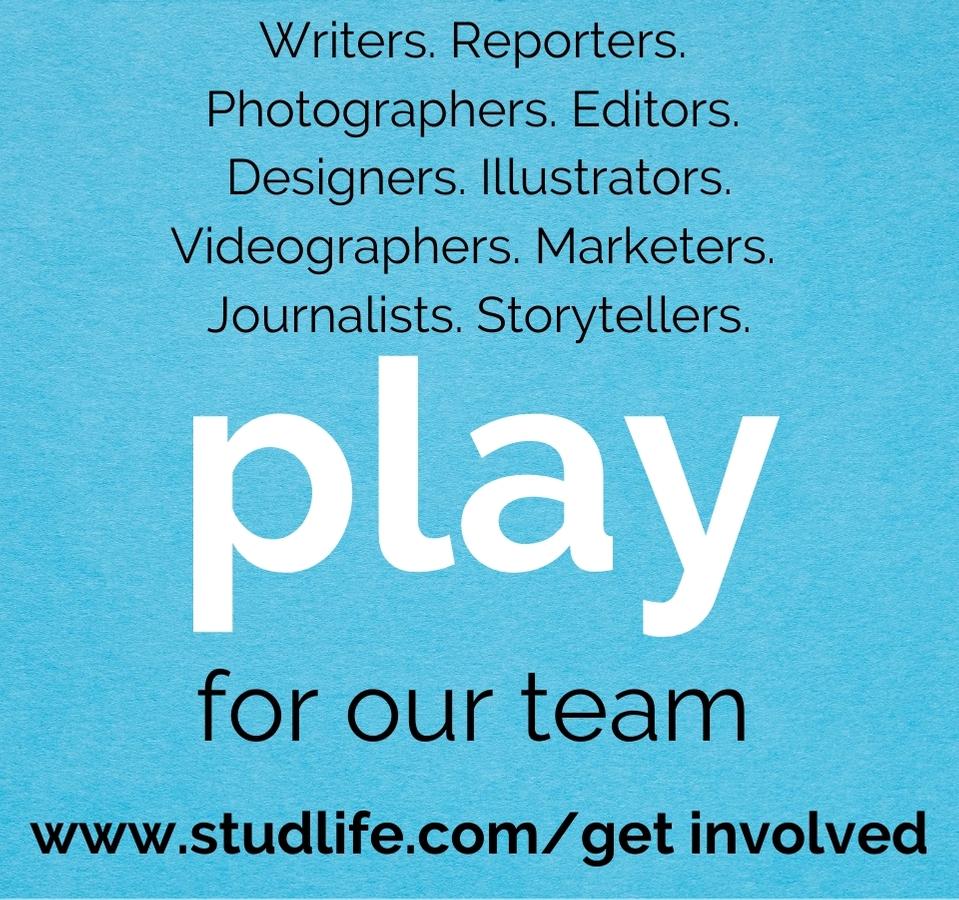
The Washington University men’s and women’s track and field teams won the annual WashU Invite Meet this past weekend. The men won the meet with 183 points, while the women took care of business at their end with 236 points. The weekend’s major highlights were seniors Ella Behrens and

Emily Konkus’s incredible record-breaking performances at the annual WashU Distance Carnival.
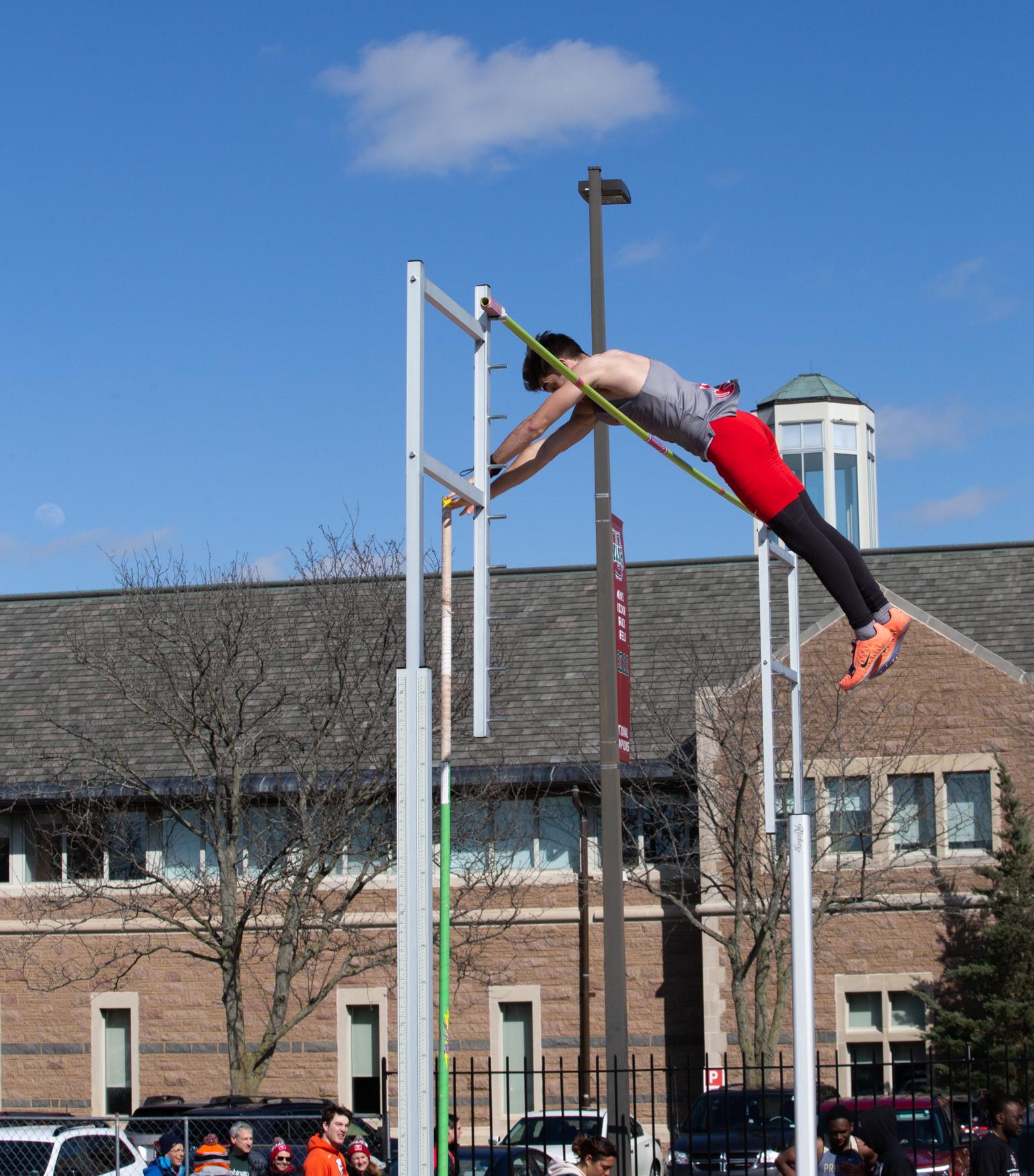
Konkus and Behrens both broke WashU program records. Konkus finished eighth in the 5,000m run, putting up a time of 16:51:00, which is ranked fifth nationally and first in the program’s history. Behrens came fourth in the 10,000m run with a time of 35:13:23, which ranks sixth nationally and first in program history.
The Distance Carnival event was scheduled to take place Friday, March 31, but due to storms that passed through St. Louis that evening, the event was rescheduled to Saturday, April 1.
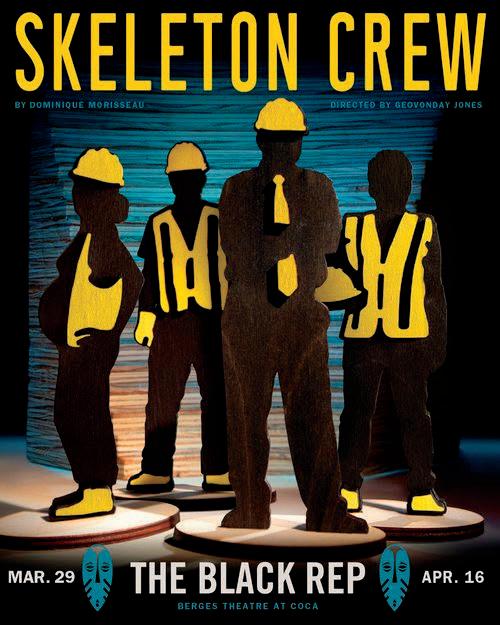



Men’s: WashU Invite and Distance Carnival


On Saturday, the men’s track won its second straight meet of the outdoor track season, besting the Greenville University men’s track team that finished the day with 114 points.
Over the course of several events, the Bears’ impressive win was led by senior Gio Alfred, who won the 110m hurdles race with a time of 14:40.
Junior Seif Elkhashab won the men’s shot put competition with a hurl of 12.89m; and the WashU’s 4x400 team of sophomore Ryan Githuku, junior Alex Djetto, senior Aidan Smyth, and senior Marcus-Jay Wilkes finished second with a
time of 3:20:23 which ranks 19th nationally.
Other notable individual performances came from jumper senior Abayomi Awoyomi, who had himself a field day as he won the triplejump competition with a mark of 14.24m, which ranks third in the Bears’ program history and sixth nationally. The senior also came second in the long jump.
But despite what, on paper, looked like a great performance, Awoyomi noted that he wasn’t too happy with his jumping techniques “It’s really just technique stuff,” he said. “With long

jump, I even took a short approach today because I was doing both on the same day. On the long jump, just focus on hitting that board and popping up. And then on the triple jump, just focus on keeping my first face low so I can cover more ground. Those are things I wish I could have done better today. But again, I’m not disappointed. Just I wish it was a little better.”
At the Distance Carnival, the men performed really well.
Santoro won the 800m run with a time of 1:52:07, which ranks third nationally.
Senior Jeff Candell finished sixth in the 3,000m
steeplechase, racing to a time of 9:11:51, which ranks sixth nationally.
Graduate student Thomas Penney finished sixth in the 1,500m run, racing to a time of 3:52:85, which ranks 13th nationally. Junior Frankie Lynch took seventh with a time of 3:52:56, which is 15th nationally.
“Going into the race, obviously I was pretty nervous,” Lynch said. “I get pretty tense up before races. But in the race, I was trying to stay under control, stay behind that frontpack. Then [when] we were coming out on the curb, I was like, ‘I gotta do it now.’ And I saw the pacer drop out. I was like, right, that’s my cue. I’m taking that. And then I just kicked it.”
Women’s: WashU Invite and Distance Carnival
On Saturday, the #2 nationally ranked women’s track team cruised to its second straight meet victory of the year with 236 points, over second-place Greenville University, who finished the day with 85 points.
Over the course of several events, the Bears’ impressive performances were led by sophomore Nicole Stewart, who won the 100m race with a time of 12:07, putting up the fourth-best time in program history and eighth nationally this outdoor season.
A 4x400M relay team of sophomore Ruby Kaplan,
Stewart, sophomore Morgan Fowler, and junior Kathyrn Leighty won the event with a time of 4:04:12, which ranks 19th nationally. Leighty also won the 400m with a time of 1:00:95.
Sophomore Lauren Gay finished third in the 200m dash with a time of 25:43 but went on to win the 100m hurdles with 14:55.
“There were a couple of things I needed to work on,” Gay said. “With hurdles, just my start wasn’t too good. But overall, I felt good. I finished fast, so it was good.”
At Distance Carnival, the women’s track performed well too. Junior Emma Kelley ran the best 800m time so far this season in NCAA DIII Women’s outdoor track with a time of 2:06:72.
Senior Aoife Dunne won the 1,500m run with a time of 4:29.48, which is also the top time this season in NCAA DIII Women’s outdoor track.
Both the WashU Invite and the Distance Carnival are the last track events to be hosted on the Francis Olympic track until next year. For graduating seniors, Saturday was the last time they would ever get to compete at home.
“It’s a little bittersweet, but I know it’s a really proud moment for me,” Awoyomi said. “Just seeing the combination of my hard work from freshman year to COVID. I’m proud of how far I’ve come.”
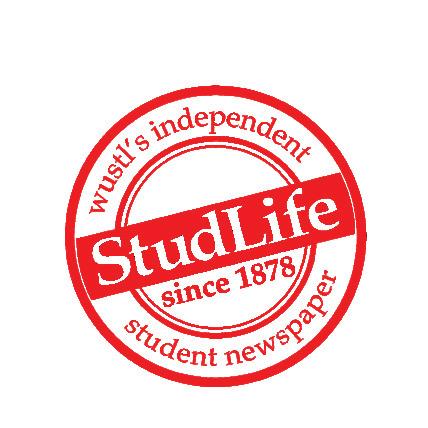
When Major League Soccer (MLS) announced St. Louis as the site for its newest expansion team in 2019, most Washington University students likely paid little attention to the news. Now, almost four years later, it’s nearly impossible to walk around Mudd Field without seeing the navy-blue and pinkish red hues of St. Louis City SC’s (STLSC) logo on hats, sweatshirts, and more. STLSC, which started MLS play just over a month ago, has quickly taken the city, the league, and WashU’s campus by storm.
While it can be easy for fans to rally around a new team, it’s even easier for them to rally around a new team that’s shattering records and expectations every chance they get. Entering the season, MLS predictions varied widely, but one feature was constant: STLSC near the bottom of projected standings. However, after the first six games of their inaugural season, STLSC sits at the top of the league, boasting more points than each of the 28 other MLS franchises.
Although they faltered for the first time when they lost 0-1 to an undefeated Minnesota United side on Sunday, their 5-0-1 record (15 points) and +10 goal differential to start the season are both the best in the league. In addition, the five-game winning streak in their inaugural season is setting new standards for MLS expansion sides, breaking the record that the Seattle Sounders had held since their 3-0-0 start in 2009. The side has relied on a variety of players to lead the charge. They have started
different lineups in all six games, although a few stars are already standing out.
Striker João Klauss, a 26-yearold from Brazil, scored or assisted in STLSC’s first five matches — including an 86thminute winner in the side’s first game against Austin FC.
Central midfielder Eduard Löwen, who floated around the German Bundesliga before moving to the States, is making an impact, too.
In addition to scoring the go-ahead-goal in the home opener against Charlotte FC, the German leads the team with three assists. Finally, 32-year-old Roman Bürki, a Swiss goalkeeper who starred at Borussia Dortmund for most of his career, has been vital between the sticks. Prior to Minnesota United’s late goal, the STLSC defense had gone 345 consecutive minutes without conceding.
While the play on the field has been incredible, the stadium surrounding it has also received raving reviews. The 22,500-seat venue — which cost nearly 460 million dollars to develop — is located downtown in close proximity to Union Station and Gateway Park.
“I really enjoyed the experience of watching a game at CITYPARK,” said firstyear student Matt Eisner, who described the stadium as “absolutely beautiful.” In his visit to a game for STL City 2 — STLSC’s academy squad that competes in the MLS Next Pro League — Eisner quickly fell in love with the stadium. No seat at the stadium is more than 120 feet from the action, a detail that Eisner noticed.
“I sat in the 13th row, but I felt like I was sitting right next to the action. The sightlines are incredible, and
the stadium atmosphere is extremely intimate,” he said.
Fans are packing the stadium, selling out the venue in all three of the team’s opening home games. While the crowds contribute to a great atmosphere, they also drive up ticket prices. According to SeatGeek, the official ticketing partner of STLSC, CITYPARK has had considerably higher ticket prices than the rest of the MLS. Although most teams in the MLS have average ticket prices in the $30-40 range, STLSC’s average entering the season was $73, $15 more than the next-closest competitor. And due to enthusiasm about the squad’s hot start, prices have increased even more. Currently, the lowest prices listed on SeatGeek’s website for the team’s remaining April home games are about $110.
Although the price is high, the team is able to rely on passionate fans and the city’s incredible soccer culture to maintain demand for the games. In addition to the massive community of local soccer fans, WashU students from across the country are eager to join the ranks of STLSC’s spirited fanbase.
“People here really care about their teams, and support for City is radiating across the region,” Eisner said. “I tried to watch the first STLSC game at Llywelyn’s in Webster Groves, but when my friends and I tried to get a table half an hour before kickoff, there was already a three-hour long wait.”
For many years, the St. Louis soccer community was a sleeping giant among American fanbases. Known colloquially as “America’s First Soccer Capital,” the city has produced talented
players such as US Women’s National Team captain Becky Sauerbrunn, Men’s World Cup starters Tim Ream and Josh Sargent, and former MLS star and TV commentator Taylor Twellman. Although St. Louis lacked a professional soccer team to rally behind, its fanbase persisted. Now that the city finally has a team to call its own, the fans packing CITYPARK are making viewers across the country wonder why it took MLS so long to give the Gateway City a top-tier team.
Sophomore Mordecai Ethapemi — just like Eisner — has already become enthralled by the passionate soccer community of St. Louis. Ethapemi said one of the best attributes of the expansion team is that “It opens up the avenue to take a look at local talent,” such as WashU alum Sergio Rivas. Rivas, a 22-year-old right back, joined the STLSC 2 developmental side after leaving WashU, and is a regular contributor for the squad.
Although he is from Maryland, Ethapemi is now closely following the team. Just like many other WashU students, he has added a game at CITYPARK to his St. Louis bucket list.
“The team poses a great opportunity for St. Louis,” he said. “[St. Louis] had a huge culture that kind of went out because [it] had no MLS teams for a while. Now it’s back, and it’s exciting to see how much it’s brought back this feeling of community, and really pushed the St. Louis soccer community out of the void.”
The top of the order for Washington University baseball is made up of three underclassmen who have been making some noise. Chris Jacinto didn’t begin the year with a starting role, but he’s worked his way into the starting spot at second base. After having one at-bat in the team’s first series of the season, he’s hit over .400 in three games this season. Jacinto sat down with Student Life to chat about Texas baseball, his transition to WashU, and his superstition that started when he hit the first homer of his collegiate career against Westfield State.

Student Life: Starting off, run me through your baseball background — how you got started and what positions did you play as a Little Leaguer?
Chris Jacinto: I played
a bit of a change. And then I played in Houston, Texas… there’s a lot of competitive baseball going on down there.
SL: So then how did you get to St. Louis from Texas?
CJ: WashU was my number one choice since junior year. I went to a showcase over the summer in Long Island [where Bloom recruited]. In case WashU didn’t work out, there were a bunch of other schools, but I made sure to talk to coach Bloom and at the time coach Rosen to try to get a good spot on their radar. So that’s how I got to know WashU — the academics drove me to play at WashU, and then the baseball was an additional thing.
SL: Talk to me about the beginning of the season and how you’ve solidified your starting position at second base — a spot with a lot of upperclassmen competition.
CJ: At the beginning of the year, I was struggling a bit. I would get contact here and there, but I was nervous. I wasn’t used to college baseball; it’s a different animal. And then one weekend against Illinois-Wesleyan, I settled in. I had a good game [and that] gave me confidence to go out and play my game. And ever since then, it’s felt really good to play good baseball and to be a starter.